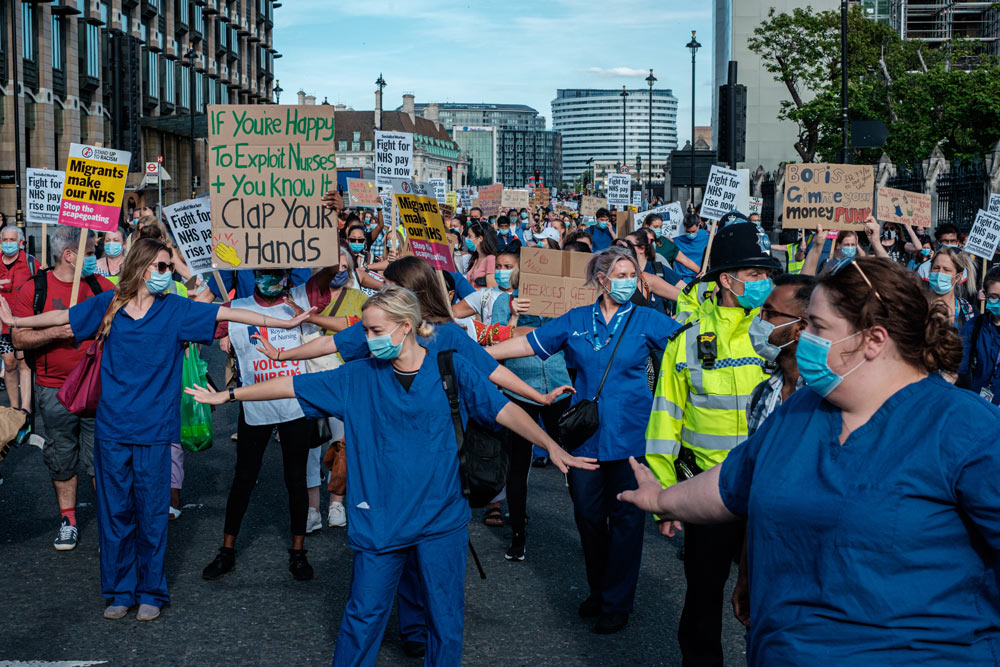

Last month, as NPQ covered, at Uber, Lyft, and Juno, a coordinated global labor action in over two dozen cities worldwide resulted in thousands of drivers refusing to log in for a day to the ride-hailing companies. Last fall, at Google, as reported in Wired, “Thousands of Google employees and contractors around the globe…walked off the job…to protest Google’s handling of sexual harassment claims and other workplace issues, and to demand more transparency around harassment incidents and pay levels at the company.”
Labor activism has shown up in other places too—whether it is the growing successes of the National Domestic Workers Alliance (NDWA) to win rights for care workers, the efforts of Restaurant Opportunities Centers-United (ROC United) to end lower minimum wages for tipped workers, or the long string of state and local victories of the Fight for $15 movement.
We have also witnessed a spate of more traditional strikes—most notably, the #RedforEd teacher strikes in 2018 in states like West Virginia, Oklahoma, Arizona, and Kentucky—followed by another set of strikes this year in cities like Denver, Los Angeles, and Oakland. Labor activism has also emerged in the art world and in digital media. Even in the grocery business, this spring, a strike in New England was staged by 31,000 Stop N Shop workers, and while the workers did not get all of their demands met, they were by and large successful in what was one of the larger US private sector strikes of recent times.
Federal labor statistics back up the anecdotes. There has indeed been an upsurge of labor activism. In 2018, the federal Bureau of Labor Statistics reports that “there were 20 major work stoppages involving 485,000 workers.” This is the greatest number of reported major work stoppages—“major” being defined as work stoppages involving 1,000 workers or more—since 2007 and the greatest number of workers affected since 1986.
This may sound impressive, and it does reflect a change from the recent pattern. But if one looks back historically, it is apparent how deep a hole the labor movement faces. It is worth noting here that 20 strikes a year in a nation the size of the US is not exactly a large number. Indeed, from 1947 through 1983, the number of work stoppages always exceeded 80 and the number of workers involved always exceeded 500,000. Typically, more than a million workers would participate in well over 100 labor actions a year throughout the postwar era.
The 2018 numbers only seem large because of the recent record, including a stunningly low five major work stoppages involving 12,500 workers in the Great Recession year of 2009. As federal data show, 2018 represents the first year in a decade when the percentage of working time lost to work stoppages reached the threshold of one one-hundredth of one percent. Stated differently, in 2018—the year with the highest level of US labor activism in the 21st century—99.99 percent of work hours were unaffected by work stoppages.
Why Labor Strength Matters
Of course, the fact that the labor movement in the US has declined is hardly a matter in dispute. A year ago, I noted:
In 1945, 35.4 percent of private sector, nonagricultural workers were in unions. According to the US Department of Labor, figures for 2017 reflect that the number in the private sector is a paltry 6.5 percent. Only the continued strong (34.4 percent) presence of unions among public sector workers keeps the overall union membership rate in double digits (barely), at 10.7 percent.
For the record, in 2018, private sector unionization fell to 6.4 percent and public sector unionization fell to 33.9 percent, leading to an overall rate of 10.5 percent. And, if you need confirmation of decline from popular culture—quick, think of the last Hollywood film you saw about labor unions. My guess is the film you chose was made a while ago. When I typed “Hollywood movies about unions” in Google, 23 movie titles came up, but none of them were produced in the last quarter century. 1992’s Hoffa was the most recent film listed. (One recent exception is 2018’s sci-fi comedy Sorry to Bother You, which, while hardly a traditional labor film, does have a strong union theme).
But why should folks who are not in the labor movement care how labor fares? The short answer is that, historically speaking, labor strength has a good deal to do with how well society meets a wide range of social justice goals. Care about income or wealth inequality? How about the racial wealth gap? Then you might want to care about the power of working people.
As Kevin Drum notes in Mother Jones, “Since 1980—that is, the era in which labor unions were more or less powerless—the incomes of the rich have gone up nearly 200 percent. The incomes of the rest of us have gone up 15 percent.” This increase in the power of the wealthy has coincided with increased corporate concentration. Writing in Vox, Ezra Klein cites the work of Columbia law professor Tim Wu, author of The Curse of Bigness: Antitrust in the New Gilded Age, who writes that, “In the United States, between 1997 and 2012, 75 percent of American industries became more concentrated.”
As for racial inequality, it is notable, as I have written before, that while the ratio of Black wages to white wages increased in the 1950s and 1960s (when unions were stronger), that ratio has since stagnated. In 1949, Black median income was 51 percent of white median income; by 1969, that ratio had increased to 61 percent. Today, 50 years later, that number remains 61 percent.
Can Policy Even the Institutional Scales?
Klein in Vox recalls the notion of countervailing power, introduced by the famed late economist John Kenneth Galbraith in 1952 in American Capitalism: The Concept of Countervailing Power. Galbraith argued that the most important constraint on American business was not US Security and Exchange Commission (SEC) regulations or even antitrust law, but rather the countervailing power of another institution—namely, the labor union. As historian Kim Phillips-Fein, writing a retrospective essay on Galbraith’s work several years ago, put it, for Galbraith, “the way to curb [corporate] power was to create institutions—strong labor unions, consumer associations, farmers’ groups— that could match their economic might.”
Sign up for our free newsletters
Subscribe to NPQ's newsletters to have our top stories delivered directly to your inbox.
By signing up, you agree to our privacy policy and terms of use, and to receive messages from NPQ and our partners.
Drum in Mother Jones takes the literal road as to how to restore that countervailing power. Drum writes that today, “The only legislation that matters would be legislation that makes it possible to organize the service sector with the same power and efficiency that unions organized manufacturing back in the first half of the 20th century. That means wiping Taft-Hartley off the map. Passing card check. Outlawing right-to-work laws. Appointing an NLRB [National Labor Relations Board] that will vigorously enforce labor rights.”
For a moment, let’s try on Drum’s political fantasy, in which Democrats not only secure the presidency but gain sufficient majorities in Congress to push through the legislation proposed. Surely, many more Americans would join unions if labor law were altered to increase union rights and decrease corporate rights. After all, in Canada, probably the country that is closest in legal structure to what Drum recommends, the unionization rate is more than twice as high (25.9 percent). At present, 14.7 million Americans are in labor unions; doubling that number would be a very big deal.
Still, the relationship between the law and institutional growth is not always direct. For example, in 2018, the US Supreme Court in its absurd but predictable (given its pro-corporate majority) Janus decision made “right to work” (i.e., a ban on mandatory union dues payments) the law of the land in the public sector. Public sector union membership numbers have fallen some, but the most visible post-Janus response by public sector unions has been the rising wave of #RedforEd strikes—which, it seems safe to say, is not what the Janus plaintiffs anticipated.
Klein’s take on Galbraith may be more apropos to the current moment. Klein writes that, “A rediscovery of Galbraith’s ideas could clarify [for political candidates] the deeper argument they’re having and permit clearer questions: Which institutions would they like to see gain power, and how would they do it? Which sectors would they like to see lose power, and what would that mean?”
In short, what are institutional changes that could sustain social justice gains over the long haul? It’s a critical question, one largely missed in discussions that more narrowly focus on who has “the best” policy response—as if one could deal with matters like health, education, racial justice, or economic inequality without addressing power.
Certainly, boosting labor unions could help rebalance the institutional field. But the service sector economy today is vastly different than the manufacturing economy of the 1930s. Might the institutional response to achieve today’s social justice objectives need to be different as well?
In many cases—at Google, at Uber, with the NDWA, with ROC United, even the Fight for $15 movement—the path followed by workers, even when backed by unions, has not been that of collective bargaining. In part, this is simply a pragmatic response to a broken system, but there is more to it than that.
Thomas Kochan, a management professor at the Massachusetts Institute of Technology (MIT), likens last fall’s Google walkout to that of 25,000 nonunion grocery workers in 2014 at a grocery chain called Market Basket. At Google, the walkout protested the company’s failure to enforce rules against sexual harassment (as well as its failure to address pay inequity). Ultimately, Google workers prevailed in getting the company to scrap mandatory arbitration, a tool that had been used to contain sexual harassment claims (although it would appear, from two whistleblower cases, that their victory has been less than total).
At Market Basket back in 2014, the walkout lasted six weeks and ultimately succeeded in reinstating a CEO who had been removed because of strategic differences with the board. Both of these conflicts occurred outside of labor law. After all, labor law separates workers from management, but at both Google and Market Basket, many supervisors were on the workers’ side—the lines of division were different. Moreover, at Market Basket, as Kochan explains, the very topic of the dispute—“Business strategies affecting pricing, customer service, investments and corporate governance”—is not even an allowable topic of negotiation under US labor law. Kochan suggests that creating “enterprise-wide councils”—as used in some countries like Germany—might be one institutional change that could help.
The nation’s two million homecare workers—expected to become four million workers by 2030—might seem to follow more traditional labor-management lines. But that would require an industry-wide reorganization. Right now, with 95 percent employed under the table, other means are required, and the approach that NDWA employs is much more similar to community-based worker organizing projects that link workplace organizing to a broader agenda of immigrant empowerment. As Lauren Hilgers writes in the New York Times, the NDWA under Ai-Jen Poo has followed a multifaceted strategy that has included passing “domestic worker bill of rights” laws in eight states (with federal legislation proposed). Specifically, Ai-Jen outlines to Hilgers a five-vector strategy that includes building economic power, legislative advocacy, protests, changing narratives (to better value domestic work and workers), and supporting model efforts—such as the Cooperative Home Care Associates (CHCA) worker cooperative in New York City.
Then there are the Uber workers, who although deemed independent contractors, effectively are low-wage employees estimated to earn $14.73 an hour. These workers are joining groups like Gig Workers Rising, as well as pursuing cooperative ownership strategies like the care workers at CHCA, in this case under the moniker of platform cooperativism—that is, driver-owned apps.
The challenges, certainly, remain immense. Still, the rise of militancy in so many different areas—and taking place in so many different ways—is a hopeful sign.
What will be the path? If labor revives, clearly it will require a mix of both “old” institutional forms and “new.” As Rob Witherell, a Steelworker representative, observed a few years ago, at its most basic level, the labor movement isn’t about unions as organizations. “It is about workers helping each other out to create a better life for themselves.”











